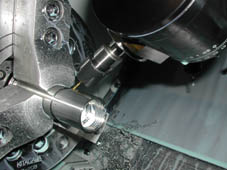 The process of cutting, shaping and finishing a piece of metal is defined as milling. Most shops consider turning and milling as part of their production mix simply because stand-alone machining centers and turning centers are basic components of a shop's manufacturing capacity. Machines that combine machining operations on a single platform are not atypical as many might think. The most successful illustration of combining metalworking process technology is the CNC machining center. Prior to its development, specific machines perform specific operations. Workpieces requiring different operations move from machine to machine. Each step requires orientation, trimming and re-clamping of the workpiece.
The process of cutting, shaping and finishing a piece of metal is defined as milling. Most shops consider turning and milling as part of their production mix simply because stand-alone machining centers and turning centers are basic components of a shop's manufacturing capacity. Machines that combine machining operations on a single platform are not atypical as many might think. The most successful illustration of combining metalworking process technology is the CNC machining center. Prior to its development, specific machines perform specific operations. Workpieces requiring different operations move from machine to machine. Each step requires orientation, trimming and re-clamping of the workpiece. 多数工厂把车削与铣削看成是他们生产混合中的组成部分,仅仅是因为单独的加工中心与车削中心是一间工厂生产实力的基础构成。在一个平台上结合多个加工作业的机器并非如很多人可能想的那么非典型的。结合金属加工工艺技术的最成功例子是电脑数控(CNC)加工中心。在其发展之前,特别的机器完成特别的作业。需要不同作业的工件在机器之间移动。每一步骤需要对工件进行定位、修边和再次箝位。
What is milling? Milling is one of several metalworking processes that include turning, welding and fringing. It is used when more complex metal shapes are desired. The process is used to create a number of metal parts and structures on everything from rings and bracelets to bridges and freight ships. Typically, milling involves cutting away pieces of metal to create dovetails, threads, bevels, slots, and ridges. The grooved edges of coins are a simple example of the milling process. Milling is done using milling machines, which consist of a cutter that rotates on an axis similar to a drill bit and an adjustable worktable upon which the metal is placed. Accessory parts include a vise or clamping kit that attaches the metal to the worktable, a digital scale, and a point master. The cutter is fixed into position and can only move up and down, while the worktable is able to move up and down as well as side to side and front to back. In most cases a single cutter is used; however, it is possible to simultaneously use several cutters during the milling process. The rotating cutter is used to cut the metal. There are several types of cutters or mills including end mills, facing mills, and form mills each serving a different purpose. For example, end mills cut slots and pockets; face mills cut flat surfaces; form mills are used for milling dovetails and bevels in metal. The three most important factors in the milling process are rotation speed, the cutting depth and the sending speed, or the rate at which metal is fed to the cutter. There are three different types of milling machines: vertical, horizontal and a combination of the two. Vertical and horizontal milling machines are most commonly used. In a vertical milling machAir Max 95 20th Anniversary













